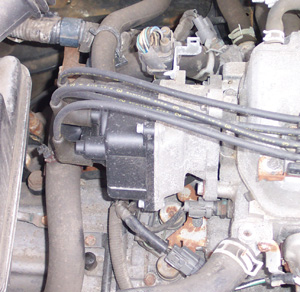Most late model engines have some type of distributorless ignition system (DIS). This includes “waste spark” DIS systems with coil packs and plug wires, Coil-On-Plug (COP) ignitions (with no spark plug wires), and
Coil-Near-Plug (CNP) ignition systems with individual coils for each cylinder and short spark plug wires.
 The spark plugs are located in the cylinder head, and provide the spark that ignites the air/fuel mixture in each combustion chamber. Each spark plug has a ceramic insulator around a conductive center electrode. At the firing end of the plug are one to four side electrodes, to which the spark jumps when the plug fires. Some plugs use multiple electrodes to reduce electrode wear and improve ignition reliability. Spark plugs are a maintenance item and must be replaced at specified mileage intervals to assure good ignition performance (typically 45,000 miles with
The spark plugs are located in the cylinder head, and provide the spark that ignites the air/fuel mixture in each combustion chamber. Each spark plug has a ceramic insulator around a conductive center electrode. At the firing end of the plug are one to four side electrodes, to which the spark jumps when the plug fires. Some plugs use multiple electrodes to reduce electrode wear and improve ignition reliability. Spark plugs are a maintenance item and must be replaced at specified mileage intervals to assure good ignition performance (typically 45,000 miles with
standard plugs, or 100,000 miles with long-life platinum or iridium plugs).
Spark plugs come in different sizes, thread pitches, lengths and designs. The “heat range” (operating temperature) of the plugs will vary depending on the application, as will the electrode gap. The heat range must be correct for the application to prevent plug fouling (too cold) or detonation (too hot).
Electrode wear and fouling can cause misfiring. Platinum and iridium electrodes are used in long life plugs to reduce wear and extend plug life. Standard plugs can be upgraded to platinum or iridium plugs to reduce the need for maintenance.
Care must be used when changing spark plugs in engines with aluminum heads because the plug threads in the cylinder heads can be easily stripped during removal or installation. The electrode gap on new spark plugs is usually preset at the factory, but may require adjusting with a spark plug gap tool or feeler gauge.
Spark plug wires are not used on coil-on-plug ignition systems because the ignition coils are mounted directly over the spark plugs. But on engines that have plug wires, the wires carry high voltage from the distributor or ignition coils to the spark plugs. Ignition cables come in various types (suppression core and inductive or “mag” wire core), with different types of insulation, lengths and diameters (7mm and 8mm).
Spark plug wires must be replaced if the insulation is burned or damaged, if internal resistance exceeds
specifications, or if the spark plug boots or terminals are loose or damaged. Replacement wire sets must be approximately the same length as the original wires. Plug wires may be replaced individually or in complete sets. Wires should be changed one at a time to avoid mixing up the firing order. Wire sets can also be upgraded to ones with better insulation and/or more conductive cores to improve ignition performance and reliability.
On older engines with distributors, the distributor routes high voltage from the ignition coil to each of the spark plugs. The
distributor cap and rotor are wear items, and should be inspected and replaced periodically, or replaced if burned or cracked.
On older engines, a magnetic or Hall effect pickup is located inside the distributor to generate a timing signal. The pickup signal goes to an ignition module, which may be located in or on the distributor, or someplace else. The module then switches the ignition coil on and off to fire the spark plugs. The module may also vary spark timing depending on engine speed and load, or the engine computer may perform this function. Modules can overheat and fail, causing the engine to stall and not restart. Many modules must be installed with special dielectric grease underneath to conduct heat away from the module.
Ignition coils create high voltage to fire the spark plugs. On older engines with a distributor, one coil is commonly used (though a few import engines may have two coils). On distributorless ignition applications, there may be one coil per spark plug, or in a “waste spark” DIS system, there is one coil for every two spark plugs (shared spark). Coils run hot and can fail from overheating, causing a weak spark or no spark. On a distributor system, a bad coil may prevent the engine from starting. On a DIS or COP system, a bad coil will cause the affected cylinder(s) to misfire. This will usually turn on the Check Engine light and set a cylinder-specific misfire code.
Distributorless ignition systems use the Crankshaft Position Sensor (CKP) to generate trigger and timing signals for the ignition system. The crank sensor may be located on the front, rear or side of the engine. It may read a notched wheel on the crank pulley, crankshaft or flywheel. The sensor may be a magnetic sensor or a Hall effect sensor. Magnetic sensors generate an alternating current (AC) signal that changes in frequency and amplitude with rpm.
Hall effect switches produce an on-off digital voltage signal. A bad crank sensor can cause loss of spark, intermittent misfiring or a no start due to no spark. Some crank sensors require a special adjustment procedure when they are replaced.













